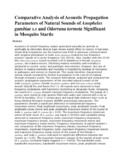Comparative Analysis of Acoustic Propagation Parameters of Natural Sounds of Anopheles gambiae s.s and Odorrana tormota Significant in Mosquito Startle

Date
2019-08-05Author
Mang’are, P. A.
Ndiritu, F. G.
Rotich, S. K.
Makatiani, J. K.
Rapando, B. W.
Metadata
Show full item recordAbstract
Acoustics of varied frequency ranges generated naturally by animals or artificially by electronic devices have shown startle effect to insects. It has been shown that mosquitoes use the reactive near-field in antennae communication with negative phonotaxis in male Aedes diantaeus evoked by low frequency acoustic signals of a carrier frequency 140–200 Hz. Also, studies with the 35-60 kHz Odorrana tormota sound recorded a 46 % repellence in female Anopheles gambiae, the malaria vectors. Declining malaria morbidity and mortality is attributed to current vector and pathogen interventions. However, the rate of decline in malaria morbidity and mortality is impeded by buildup of resistance in pathogens and vectors to chemicals. This study therefore characterised animal sounds essential for further investigation in the control of malaria through mosquito startle. The research determined, analysed and compared the acoustic propagation parameters of the recorded natural sounds of the male Anopheles gambiae, female Anopheles gambiae and Odorrana tormota using Avisoft SASLAB Pro and Raven Pro 1.5. All sounds were observed to have frequency modulation with harmonics stretching to ultrasonic levels. Uniquesly, the sound of O. tormota showed constant frequency modulation. The pupae of A. gambiae were reared in vials quarter filled with water and covered with a net at 60-80 % humidity, 25±2 °C temperature and equal light-darkness hour cycle at Kenya Medical Research Institute (KEMRI) entomology laboratories. The parameters showed a significant deference in fundamental frequency (maximum entire), Peak amplitude (maximum), peak amplitude (mean), Peak amplitude (mean entire) and peak amplitude (maximum entire) of the sound of male A. gambiae and O. tormota (p < 0.05). The maximum frequency (minimum entire) of both sexes of A. gambiae was equal (1.90 kHz) with variability being observed in maximum frequency (end), maximum frequency (maximum), maximum frequency (mean), maximum frequency (maximum entire) and maximum frequency (mean entire). Frequency (maximum). A paired samples t-test comparison of the maximum frequency (mean), maximum frequency (maximum), maximum frequency (end), maximum frequency (maximum entire) and maximum frequency (mean entire) of the sound of the female A. gambiae and male A. gambiae indicated no significant difference between the sounds (p > 0.05). The maximum frequency (mean) of the sounds of both sexes of A. gambiae correlated highly negative (r = −0.658). The bandwidth (end), bandwidth (maximum), bandwidth (maximum entire), peak amplitude (mean) and bandwidth (mean entire) of the sound of the male compared with female A. gambiae differed significantly. The signal power for the non-pulsate sounds of the male A. gambiae remained almost constant at 80 dB from 10 kHz to 65 kHz beyond which the acoustic energy declining to 45 dB. Also, the sounds of the female A. gambiae did not exhibit any spikes in power but remained steady at 85 dB from 10 kHz up to 60 kHz beyond which the acoustic energy declined to 50 dB. The signal power of the pulsate sound of O. tormota was 89 dB. The propagation parameters of the male mosquito and O. tormota compared favourably indicating its potential in the startle of the female mosquito.
URI
https://doi.org/10.1101/725960https://www.biorxiv.org/content/10.1101/725960v1.full
http://r-library.mmust.ac.ke/123456789/1728
Collections
- Gold Collection [1026]
